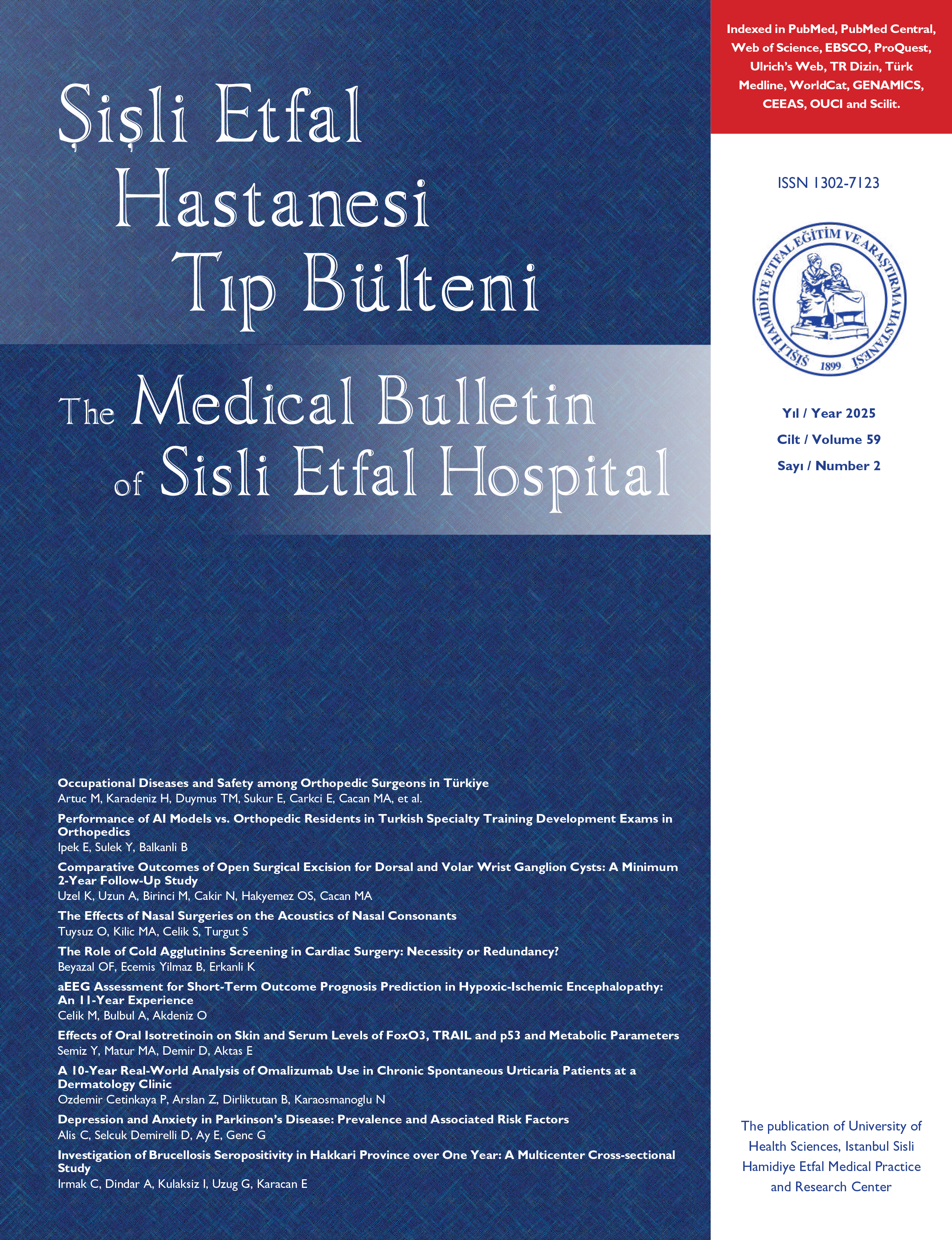
Risk Factors and Mortality in Newborns with Persistent Pulmonary Hypertension: A Six-Year Single-Center Experience
Ozlem Sahin1, Nazife Reyyan Gok2, Derya Colak1, Taliha Oner3, Omer Guran1, Funda Yavanoglu Atay1, Ilke Mungan Akin11Neonatal Intensive Care Unit, University of Health Sciences Türkiye, Umraniye Training and Research Hospital, Istanbul, Türkiye2Neonatal Intensive Care Unit, Marmara University Faculty of Medicine, Istanbul, Türkiye
3Department of Pediatric Cardiology, University of Health Sciences Türkiye, Umraniye Training and Research Hospital, Istanbul, Türkiye
Objectives: Persistent pulmonary hypertension (PPHT) of the newborn is a disorder of circulatory transition resulting in high pulmonary vascular resistance with extrapulmonary right-to-left shunts causing hypoxemia. In this study, our aim was to evaluate the risk factors, administered treatments, and mortality of patients followed in our neonatal intensive care unit (NICU) due to PPHT over the past six years. Methods: Patients diagnosed with PPHT and followed in the NICU between January 2017 and November 2022 were included in the study. The sociodemographic characteristics, diagnoses that could lead to pulmonary hypertension, the presence of congenital anomalies, the duration of respiratory support treatment and hospital follow-up, treatments administered for PPHT, and mortality rates were evaluated.
Results: Out of 21 patients diagnosed with persistent pulmonary hypertension, 9 of them (42.9%) were male. The mean gestational age of the patients was 37.6±3.7 weeks, and their birth weight was 3006±819grams. The APGAR scores at 1 and 5 minutes were 4(2-7) and 6(3-8), respectively. Risk factors during the antenatal period included fetal distress (38.1%), oligohydramnios (23.8%), intrauterine growth restriction (23.8%), gestational diabetes (14.3%), preeclampsia (4.8%), and chorioamnionitis (4.8%). The median duration of invasive mechanical ventilation for cases requiring respiratory support was 20.1 days, while the median duration of non-invasive ventilation was 3.7 days. Patients with a diagnosis of persistent pulmonary hypertension were treated with inhaled nitric oxide (iNO) in 76.2% of cases, milrinone in 66.7% of cases, sildenafil in 52.4% of cases, and iloprost in 14.3% of cases. The length of hospital stay for patients was 38.4 days, and 9 (42.9%) patients died. The patients who died had severe PPHT along with fetal inflammatory response syndrome (FIRS), congenital heart disease, pulmonary hypoplasia, pneumothorax, hypoxic-ischemic encephalopathy (HIE), and congenital anomalies.
Conclusion: Persistent pulmonary hypertension, characterized by severe hypoxemia, is a neonatal emergency that necessitates early intervention, effective treatment of the underlying cause to prevent potential short-term and long-term morbidities and mortality. Effective treatment of the underlying cause in patients diagnosed with PPHT could reduce morbidity and mortality. It is inevitable to avoid the loss of patients with major abnormalities, severe comorbidities, and unpreventable organ dysfunctions.
Persistan Pulmoner Hipertansiyon Tanılı Yenidoğanlarda Risk Faktörleri ve Mortalite: Altı Yıllık Tek Merkez Deneyimi
Ozlem Sahin1, Nazife Reyyan Gok2, Derya Colak1, Taliha Oner3, Omer Guran1, Funda Yavanoglu Atay1, Ilke Mungan Akin11Türkiye Sağlık Bilimleri Üniversitesi, Ümraniye Eğitim ve Araştırma Hastanesi, Yenidoğan Yoğun Bakım Ünitesi, İstanbul2Marmara Üniversitesi Tıp Fakültesi, Yenidoğan Yoğun Bakım Ünitesi, İstanbul
3Türkiye Sağlık Bilimleri Üniversitesi, Ümraniye Eğitim ve Araştırma Hastanesi, Pediatrik Kardiyoloji Kliniği, İstanbul
Amaç: Yenidoğanın persistan pulmoner hipertansiyonu(PPHT), hipoksemiye neden olan ekstrapulmoner sağdan sola şantlarla birlikte yüksek pulmoner vasküler direnç ile sonuçlanan bir dolaşım geçiş bozukluğudur. Bu çalışmada, hastanemiz yenidoğan yoğun bakım ünitesinde(YYBÜ) son altı yılda PPHT nedeniyle takip edilen hastaların risk faktörleri, uygulanan tedaviler ve mortalitelerini değerlendirmeyi amaçladık.
Yöntem: Ocak 2017-Kasım 2022 tarihleri arasında şiddetli PPHT tanısı ile YYBÜde takip edilen hastalar çalışmaya dahil edildi. Olguların sosyodemografik verileri, pulmoner hipertansiyona neden olabilecek tanıları, konjenital anomali varlığı, solunum destek tedavi ve hastanede izlem süreleri, PPHT için uygulanan tedaviler, mortalite oranları değerlendirildi. Yaşayan ve kaybedilen hastalar risk faktörleri, ventilasyon ve tedavi özellikleri açısından değerlendirildi.
Bulgular: Persistan pulmoner hipertansiyon tanısı alan 21 olgunun 9u(%42.9) erkekti. Hastaların ortalama gestasyon yaşı 37.6±3.7 hafta ve doğum ağırlığı 3006± 819gr, APGAR skoru 1. ve 5. dakikalarda sırasıyla 4(2-7) ve 6(3-8) saptandı. Antenatal dönemdeki risk faktörleri: fetal distres %38.1, oligohidramnios %23.8, intrauterin gelişme geriliği %23.8, gestasyonel diyabet %14.3, preeklampsi %4.8, koryoamniyonit %4.8 oranındaydı. Solunum destek tedavisi ihtiyacı olan olguların invaziv mekanik ventilasyonda izlem süresi medyan 20.1gün, non invaziv ventilasyon süresi medyan 3.7 gün saptandı. Persistan pulmoner hipertansiyon tanısıyla izlenen olgulara inhale nitrik oksit (iNO) (%76.2), milrinon (%66.7), sildenafil (%52.4), iloprost (%14.3) tedavileri uygulandı. Hastaların hastanede yatış süresi ortalama 38.4 gündü ve 9(%42.9) hasta eksitus oldu. Eksitus olan olguların ağır PPHT ile birlikte fetal inflamatuar yanıt sendromu (FIRS), konjenital kalp hastalığı, pulmoner hipoplazi, pnömotoraks, hipoksik iskemik ensefalopati, konjenital anomali tanıları mevcuttu.
Sonuç: Persistan pulmoner hipertansiyon, şiddetli hipoksemi ile karakterize, kısa ve uzun dönemde oluşabilecek morbiditeleri ve mortaliteyi önlemek için erken müdahale edilmesi gereken, başlıca tedavisi altta yatan nedene yönelik olan bir yenidoğan acilidir. Erken başlanan tedavilere rağmen majör anomalisi olan, ciddi ek hastalığa sahip ve organ disfonksiyonları engellenemeyen hastaların kaybedilmesi kaçınılmazdır. (SETB-2023-10-199)
Manuscript Language: English



















